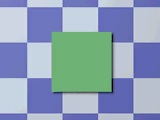
Shadows and depth
Illusory motion in depth
from shadows -- green square over checkerboard (Quicktime)
Kersten, D., Knill, D., Mamassian, P., & Buelthoff, I. (1996). Illusory
motion from shadows. Nature, 379(6560), 31.
Here's the green square with shadow without the text.
Ball-in-a-box. In this demonstration, we hold image size fixed, but allow the position of the the object to change in the image. The ball follows a diagonal trajectory inside a box. The ball's shadow first moves diagonally in a trajectory parallel to the ball, then it moves horizontally.
The ball's trajectory is the same for both segments of the animation. The apparent motion in depth of the ball is strikingly different in the two cases. When the shadow is diagonal, the ball appears to slide along the floor to the back of the box. When the shadow trajectory is horizontal, the ball appears to rise above the floor of the box.
Here is a large version of the ball-in-a-box demonstrations (4Mbytes).
Kersten, D., Mamassian, P., & Knill, D. C. (1997). Moving cast shadows induce apparent motion in depth. Perception, 26(2), 171-192.
For 12 minutes worth of assorted shadow demonstrations, you can download the 57Mbyte Shadow Demos quicktime movie.
Shadows and sterescopic depth
In this animation, the size-change is zero, and in addition there is
a disparity conflict--the demonstrations have
to be viewed with crossed-fusion.
The shadows are still quite effective, despite the contradictory disparity cue--at least initially. After a while, the disparity seems to win out the green square move appears to move towards the checkerboard background and "squeeze" the dark shadow away, then recede from the background and "suck" the shadow under itself.
Java Demonstration:
© 1998 Computational Vision Lab, University of Minnesota,
Department of Psychology.